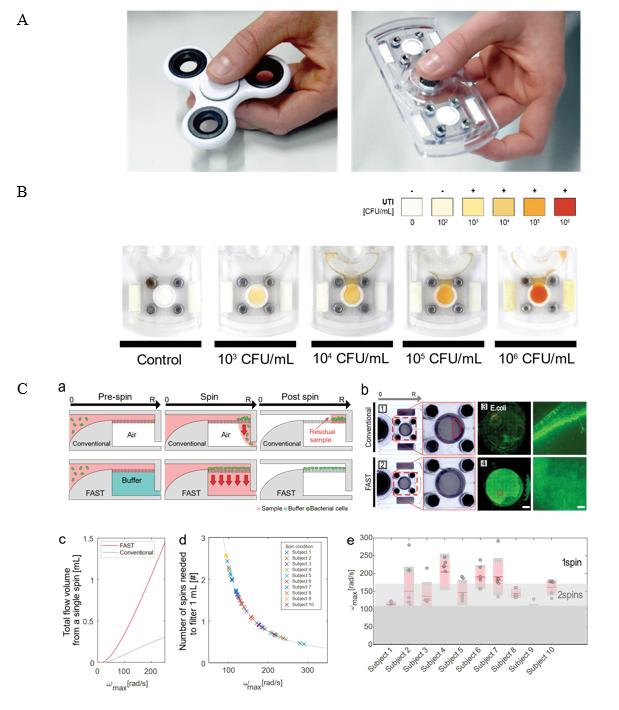A fidget spinner inspired microfluidic chip can diagnose infectious diseases at the time and place of patient care.

Credit: IBS
About 60% of women will experience urinary tract infection (UTI) at least once in their lifetime. With antibiotic-resistant organisms increasing, UTI is likely to bring more of the health and economic burden. To turn things around, point of care testing (POCT) technology has been identified as a breakthrough in diagnosing suspected UTI patients. POCT enables staff to provide real-time, lab-quality patient care when and where it is needed. Despite recent advances by POCT, every year millions of people die of treatable illness such as UTI and of the lack of diagnosis in developing parts of the world. It is a pressing need for technologies to bridge this existing gap.
Researchers at the Center for Soft and Living Matter, within the Institute for Basic Science (IBS, South Korea), reported a diagnostic fidget spinner (Dx-FS) that allows for highly sensitive and rapid diagnosis and prescription only with hand power. Fidget spinners are boomerang-shaped toys whose ball bearings reduce friction and allow things to rotate freely for a long time (Figure 1A). One flick of the fidget with a finger sets the gadget in motion. By exploiting the centrifugal force derived from the design of a fidget spinner and their novel mechanism called, a fluid assisted separation technology (FAST), the research team optimized the fluidic dynamics in Dx-FS. This mechanism enables the Dx-FS to work just with one or two spins by hand and to produce 100 times more enriched pathogens that can be easily seen by naked-eyes without the need of bacteria culture (Figure 1B).
Conventional approach for the diagnostics of the infectious disease require time-consuming cell culture as well as modern laboratory facilities. Worse yet, typical bacterial cell enrichment requires huge force and it is prone to membrane fouling or clogging due to the pressure imbalance in the filtration chamber. “Though the centrifugal force serves as an “engine” of the device, the force is felt more strongly in the outer path as it acts outwardly away from the center of rotation. The imbalanced impact of the centrifugal force keeps some of the sample left in the membrane. We utilized hydrodynamic forces that acts vertically to the centrifugal force by filling the filter membrane with liquid before the spinning process. This minimized the pressure drop and brought the uniform pressure balance throughout the entire area of the membrane. This allowed for maximized bacterial cell enrichment efficiency while minimizing the force needed for the filtration. Therefore, one or two spins were enough to filter 1 mL of sample despite large variation in the spin speed among different operators with different hand power (Figure 1C).” explains professor CHO Yoon-Kyoung, the corresponding author of the study.
In FAST-based particle separation, the fluid flow caused by centrifugal force is in a direction perpendicular to the filtration flow through the membrane. In addition, the drainage chamber underneath the membrane remains fully filled with the liquid during the entire filtration process. This is achieved by placing a buffer solution in the bottom chamber of the membrane prior to the spinning process, which ensures uniform filtration across the entire area of the membrane and significantly reduces the hydrodynamic resistance.
The research team verified Dx-FS can perform “sample-in-answer-out” analyses. The research team tested urine samples from 39 UTI suspects in Tiruchirappalli, India. Compared to the gold-standard culture method, which has a relatively long turnaround time, Dx-FS provided a comparable answer on site in 50 minutes. The experiment shows 59% of UTI suspects were over/under-treated for antibiotics, which may be saved by using Dx-FS (Figure 2). Further, they performed a rapid antimicrobial susceptibility test (AST) for two antimicrobial drugs on 30 UTI patients using Dx-FS. The test produced 100% accurate results within 120 minutes (Figure 3).
Overall, this simple, hand-powered, portable device allows rapid enrichment of pathogens from human urine samples, showing high potential for future low-cost POCT diagnostic applications. A simple tool like Dx-FS provides UTI management and prevention of resistance in low resource settings.
###
Media Contact
Yoon-Kyoung Cho
[email protected]
Related Journal Article
http://dx.




